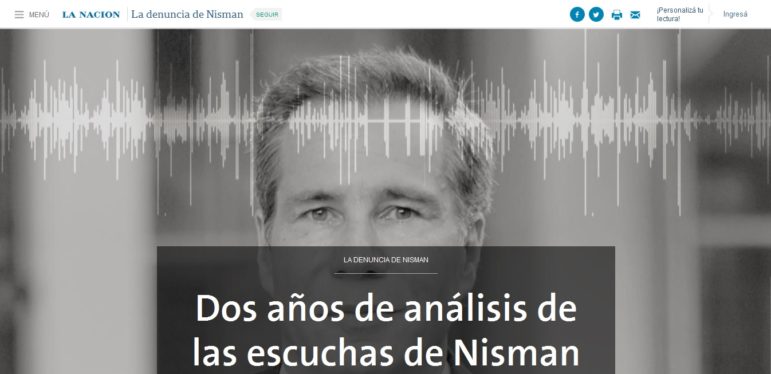

How They Did It: A Local Data Reporter Covers America’s Deadly Opioid Epidemic
Read this article in

Crossing Bridges: The footbridge next to Spokane Falls. Photo: Mike Tigas (CC BY 2.0)
For most of the time I was working on this story about health care workers dying of opioid overdoses, I didn’t really believe I’d ever finish it.
It wasn’t because I didn’t have the data. I’d done a lot of writing about opioid overdoses, relying especially on state death records to get numbers and develop a picture of who was dying in Washington. That dataset was critical for me as I added gut punches to stories about families, individuals struggling with addiction, or people trying to make sense of a loved one’s overdose.
Because I had a list of names of those who’d died, I could use their obituaries to add humanizing details about people I’d never met — while reminding readers that far more people were affected by opioid overdoses than the one or two mentioned in the story.
My first story using this death data, published in early 2016, was about a grieving father, Scott Meyers, whose 18-year-old daughter Rachel died of a heroin overdose. The numbers and names in the dataset allowed me to show, really clearly, that these deaths deeply affected families and communities:
The health department’s 2014 data lists 53 adults under 25 who died in Washington from a heroin-involved overdose. … Rachel’s name will be on the 2015 list. Her death certificate will say heroin. What it won’t say: Mt. Spokane High School honor student; Humane Society volunteer; mother to her pit bull, Sophie; soccer and volleyball player.
“Junkies are somebody’s kids,” Meyers said.
Soon after, I was moved to a health beat full-time, with a focus on addiction and mental illness.
Same Data, New Story?
I spent a lot of time in the summer and fall of 2016 fishing for stories within the data I already had. Around November, I got bored one day and found myself thinking back to some NICAR training I’d done about database “joins” (clauses that combine columns from one or more tables in a relational database). I was very familiar with the drug overdose deaths data from prior reporting, and I knew the state had a database of health care provider licensees — nurses and doctors and pharmacy technicians and counselors. It was something like 1.1 million records.
So I thought: what if I run a fuzzy match on names between these health providers and the fatal opioid overdose list? I didn’t have any real expectations going in, but it seemed like a reasonable question to ask.
At the time, the only data analysis programs I knew how to use were Excel and Access. I crashed Access trying to do a join query about half a dozen times before I pulled in Kai Teoh, one of our newsroom developers, and he used some Python magic to get me a list of fuzzy matches where birthdate matched between the two databases and first and last name were similar. It came back with about 100 matches, looking at death records from 2010 to 2015.
That kind of freaked me out, because that meant I had an actual story, and I felt like I was in way over my head. I’m not ProPublica, or even a two- or three-person investigative team at a major daily paper. I’m just one person who knew enough about databases to be dangerous. And I was terrified this wasn’t a real story and that I was making it up.
Looking for Humans in the Data
I had no idea how to approach reporting for something that seemed like way too big of a project for one person. My hope, going in, was to find a smoking gun — some reason these deaths were happening due to a system failure. But my first instinct, as a reporter, was to localize. I started cold emailing and writing and Facebook-messaging the relatives of dead people who were in the greater Spokane area.
In late December, I reached out to a woman, Tami Cleveland, on Facebook and sent her the “Hey, I think you’re related to this dead person I’m interested in, can we talk?” message. And she said yes. I was curious about her stepmother, Beth, a nurse who’d died of a hydrocodone overdose in September 2012.
We met on a January evening at Atticus, a coffee and gift shop in downtown Spokane. She had just gotten off work in central Spokane, and I was wrapping up a long day. The roads were still icy, and I was happy we’d been able to figure out a good time to meet in the city rather than her home 40 minutes outside of town.
Deeper Motivation
In talking to Tami, I started where I usually do, explaining that my aunt, Christy, died of a methadone overdose in 2013 after years of taking that opioid with a combination of other drugs for chronic pain following car crashes and other underlying health problems.
A lot of my reporting since then has been driven in part by trying to understand her death better. And to make up for it in a way — I was in college and didn’t talk to her much, or the family, because I was struggling with depression and busy with school and at the end of my rope, emotionally, so often that I didn’t feel like I had space for more. And I told myself, you’ll always have time to reconnect after you graduate. She was in her early 40s. She wasn’t supposed to die that young.
I start there with sources because it helps people open up to me, because they know that I’ve been on the receiving end of one of those phone calls that sucks the air out of your body and leaves you too stunned to say anything. I’m sure all sudden deaths are like this to some degree, but a drug overdose leaves your brain talking itself in so many painful circles for weeks and months after:
“I should have called her more.”
“Why didn’t they tell me it was this bad?”
“Why did that fucking doctor keep prescribing the same stuff after she overdosed the first time?”
And most often: This isn’t real. This can’t be real.
A Reason to Write
With Tami’s story, I saw that same struggle to come to terms with something, although her emotion wasn’t right on the surface. Most of us expect our aunts and parents to die before us. But not this young. And not like this.
I’ve interviewed family members who have lost children, teenagers or very young adults, to overdoses, and their pain is usually more recent and raw. Tami’s stepmother Beth died in 2012, so it had been a few years. But after some probing and digging into details and memories, she teared up. Beth was a nurse who was first prescribed opioids for chronic migraines, who ended up addicted to them and tried several stints of treatment to get better, ultimately unsuccessfully.
Tami gave voice to so many of the contradictory thoughts that come when you love someone who struggles with addiction. “She should have known better” came up a lot. So did feelings that it was Tami’s fault, or that she didn’t do enough to help. Sometimes it feels inevitable — they were always going to die this way. Sometimes it feels like the most unfair, random event. And sitting with all those feelings is hard for me, even still after I’ve been writing these stories for a few years. It makes me more careful, I think, and it slows me down because there’s only so much reporting I can do before I have to take a break for my own sanity.
We talked for about an hour, with me sipping tea at a table against the wall. That interview left me feeling a bit broken, but with a sense that I had to tell this story. Because even if Beth ended up being the only health provider on my list who was a real match, her story was enough of a reason to write something, even if I didn’t know what that something looked like yet.
Staring at the Screen
The project was constantly put on hold because of daily reporting pressures or just because I’d get stuck and talk myself out of working on it because I felt like a failure. I didn’t have any experience vetting a database like the one I’d created, and I worked on it in odd moments in between sending lots of panicked emails to more experienced data reporters and editors asking them if my methodology was sound.
The first thing I did was try to disprove as many of my matches as possible. I went through those rough matches manually to check them, making sure birth dates matched and names were actual matches, including a middle name or initial where we had one. That cut the list down by about 20 percent.
In March, I requested a list of provider birthdates from the Department of Health for a handful of people who weren’t listed in the credential database. I added those manually and cross-checked them against death records.

First Draft: An early version of my match spreadsheet, where I color-coded entries based on whether I had confirmed the match between databases. I later turned the color into a column field, but the ugly color visual was helpful for reporting to see progress and highlight where I should be looking for relatives to talk to.
In those first few months, I also made a lot of calls around to people I know who worked on addiction treatment and research — the opioid treatment program at the health district and some Washington State University researchers. I zeroed in on the state’s addiction treatment programs for doctors, the Washington Physicians Health Program, and its program for nurses and other providers, Washington Health Professional Services. I talked to the directors for both, and I requested Department of Health disciplinary records for cases related to suspected drug use and diversion for a five-year period. I wanted to see if any of the providers I was looking at who died from drug overdoses had been reported or suspected of using drugs.
I came back to my data in odd moments and sometimes went months without looking at it. Every time I did, I felt guilty, and I had to do extra work to catch myself up on what I’d already done — remembering the status of public records requests, rereading interview notes.
Often, that work was just staring at my screen thinking I didn’t have a story. I had some dead people and some tragedy, but there was no smoking gun. The state addiction treatment programs weren’t perfect, but both had high success rates. Far more doctors and nurses were being treated for substance abuse every year than were dying from overdoses.
Because I was working alone, I struggled with that a lot. Is this even worth telling? If all I have is a few dozen deaths over a few years, does it matter? My personal feeling, of course, is that every death matters. I could sell this one to editors because they were dead nurses and chemical dependency counselors. They should have known better, as that refrain goes. And that framing gave me an additional challenge: how do you tell a story where readers are interested because of an idea like that — “they should have known better” — and explain why it’s not that simple? How do you overcome that stigma?
By the fall of 2017, I was tired of judging myself and tired of having the story hanging over my head, and I set a goal of finishing it by the end of the year. If the story I had was Beth’s death and some interesting numbers, then that was the story I was going to tell. And so, for a few weeks in November and December, I put in the hours to reverify things and wrap up my reporting.
Nearing the End

Keeping Track: A list of files in the data folder I used while writing this story. I’m bad about writing documentation, so I try to make it as obvious as possible in file and sheet names to compensate.
My database of possible overdose deaths was still a bit of a mess, and I knew I needed to decide on a clean set of verification criteria. A lot of the matches were for expired health care licensees — some were decades old and some had expired fairly recently. Initially, I left them all there, but decided during this final stage to narrow the list down to people who had an active health provider license at the time of their death. That left me with about 70 matches.
I eventually decided I wanted to verify each death through an obituary that had a) a date of death matching the death certificate and b) a mention of a career or place of employment verifying they’d worked in healthcare. I went with a really high standard because I didn’t want to overstate the problem or suggest someone had died from something so sensitive and stigmatized unless we were absolutely sure. Using that standard, I was able to verify 33 of our 64 matches. I said in the story that we had another 30 or so likely matches, but I really didn’t want this to come off as sensationalizing. And I wanted to write a story that was about those people and was going to matter whether the number was three or 300.
Over the course of verifying those, I reached out to a few other families and found one more local overdose case that had been written about, briefly, by the Moscow-Pullman Daily News. Between that reporting and the obituaries I found, I was able to add personal details from other people who had been just names on a spreadsheet for months.
Tami’s stepmother Beth was the focus of the story. I tried to weave statistics and information from other people that I’d gathered around her story so there was a good balance between data and the human side of the issue.
After the Story
I had no idea what to expect in terms of reception. The final, published story got a lot of traffic online and was re-published in the Tacoma News-Tribune, but I didn’t receive as many comments as I often do with larger stories. A few people thanked me for highlighting the issue and getting the word out about treatment programs. Some nurses wrote to say they thought I was characterizing the profession unfairly, which wasn’t a surprise. I did what I think most reporters do with feedback like that: wrote back saying I understood their concerns and pointing out the text where I’d tried to highlight that this wasn’t most nurses or even many nurses, but it was still some and that should matter.
A few family members of dead health providers (people I’d contacted while reporting) wrote back after the story was published saying they were willing to be interviewed. I thanked them and sent them the link, and the data I had if they wanted it.
The mother of a nursing assistant who died in 2013 wrote back to me, “I hope your story will be of help to others.”
Impact can be wishy-washy and nebulous. Sometimes no laws are changed. Sometimes no one resigns. The best I can hope for is that it went out in the ether and maybe encouraged someone to get care or talk to a coworker.
My friends like to tell me that I’m too hard on myself, and that’s probably true. The data journalism community is so small and tight-knit, which is a wonderful blessing when you need someone to bounce ideas off of. It also means I’m constantly judging myself against people I view as peers who have years more experience, larger teams and more resources. So it was difficult for me to work so hard on something I thought was important and hear just a murmur of conversation about it.
Personally, everything I write about this topic feels like a small bit of vindication for my aunt. If anything I write is the bridge between someone who needs addiction treatment and a resource that can keep them alive, then that’s one less potential death out there. When I’m inclined to think the work I do doesn’t matter, that’s the thought I try to go back to.
This article first appeared on Source, a community and documentation hub for developers, designers, reporters and editors who work on news apps and data journalism projects in news organizations. It is cross-posted with permission.
 Rachel Alexander is the health and social services reporter at the Spokesman-Review and the go-to data geek in the newsroom. She’s a member of the Washington Coalition for Open Government board and the founder of Washington News Nerds, a group dedicated to bringing low-cost workshops on data journalism in the Pacific Northwest.
Rachel Alexander is the health and social services reporter at the Spokesman-Review and the go-to data geek in the newsroom. She’s a member of the Washington Coalition for Open Government board and the founder of Washington News Nerds, a group dedicated to bringing low-cost workshops on data journalism in the Pacific Northwest.









